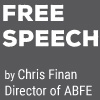Progress in the Debate Over Free Speech on Campus
“Free Speech” is a monthly column by Chris Finan, director of the American Booksellers for Free Expression (ABFE), that shares his personal thoughts and opinions on a broad range of free expression issues; the views expressed do not necessarily reflect those of the American Booksellers Association. Finan welcomes comments and suggestions at [email protected].

What a difference a year makes.
Last November, many American campuses were in an uproar. The Black Lives Matter movement had inspired students to join the protest against the persistence of racial discrimination in American society and to demand that their colleges and universities adopt policies that promote equality.
A few of those protests boiled over into demands for limits on the free speech of students who were critical of the protesters. This was met by strong criticism from the media and from some who pointed to demands for “trigger warnings” and “safe spaces” as evidence of a larger movement toward banning “harmful” speech from our centers of higher learning.
A year later, things seem considerably less dire.
An important new report by PEN America — And Campus for All: Diversity, Inclusion, and Freedom of Speech at U.S. Universities — draws on evidence from a variety of sources to present a detailed analysis of the issues involved. It concludes that there is no free speech “crisis” on campus.
The report begins by summarizing some of the demographic changes that have occurred in the United States since the 1970s. We are all aware of the growing diversity of the American population, but the changes are particularly dramatic when you look at the figures.
A recent study by the Pew Research Center cited by PEN reveals that the white population of the U.S., which was 85 percent of the total in 1960, will be cut in half by 2060. In 2010, it had already declined to 64 percent. Sixteen percent of the population was Hispanic; 12 percent black; and five percent Asian.
The change in the composition of college students is eye-opening. The number of Hispanics quadrupled between 1976 and 2013, reaching 16 percent of total students. There were 50 percent more black students (15 percent), and three times as many Asian Americans (six percent). The number of women students also grew dramatically, and they are 57 percent of all students today.
These numbers were bound to shake the foundations of American higher education. It should certainly come as no surprise that the new arrivals at Yale University objected when they discovered that a campus building was named after John C. Calhoun, a defender of slavery, or that Amherst students pressured their school to renounce the unofficial college mascot because it was inspired by a colonial military man who deliberately gave Native Americans blankets infested with smallpox.
Administrators are also learning that their choice of words is important. In 2015, the dean of students at Claremont McKenna College in California sent an e-mail to a Latina student promising to “work to serve those who don’t fit our CMC mold.” When there were protests from students who presumably didn’t fit the mold, the dean apologized and resigned.
While campus protests are undoubtedly making life more difficult for some college officials, most of the leaders of these institutions are optimistic about their impact. In a survey of 567 college and university presidents, 75 percent said the protests had increased dialog on the issue of race at their school. More than half are paying more attention to the need for more minority students, faculty, and administrators.
There is also some reassuring news about one of the most controversial strategies for dealing with campus diversity — trigger warnings. Advocates of trigger warnings argue that professors should be required to warn students of potentially offensive material that they may encounter during a class discussion or required reading.
Critics contend that trigger warnings have a chilling effect on instruction, discouraging teachers from addressing difficult but important subjects. The American Association of University Professors has opposed even the voluntary use of warnings in course descriptions. However, a recent survey of 800 college professors by the National Coalition Against Censorship revealed the use of trigger warnings is not widespread. Fewer than one percent of respondents work at institutions that require them. Seven percent reported that there was pressure for required warnings on their campus.
But if there is no free speech crisis on campus, the PEN report does highlight some worrisome facts. While more than 70 percent of students tell pollsters they support free speech and a diversity of opinions on campus, a majority also endorse regulations to ban remarks that are offensive to students who are members of a minority group.
The PEN report is critical of students who call for punishing speech by fellow students and urges administrators to resist demands for canceling campus speeches by controversial figures. Not even threats of violence at an event should be used as a pretext for cancelling it, “except in the most extreme cases,” PEN said.
In general, the PEN report encourages colleges and universities to allow students the widest latitude to express themselves.
Among its most important recommendations are those urging more education for students about the importance of free expression. This is an urgent matter considering that a survey found that one-third of students could not identify the constitutional amendment that protects freedom of speech.
The PEN report itself is evidence of a new interest in addressing the issue of free speech on campus, and other groups are organizing seminars and other occasions to engage students on the issue.
It is another reason for optimism about the latest campus unrest.


